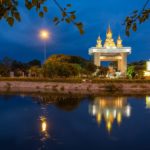The Thai Yoi Tribe of Northeast Thailand

Seen Above: Thai Yoi faculty members at Sakon Nakhon Rabjabhat University, dressed in traditional indigo-dyed attire.
The Thai Yoi (ไทโย้ย) immigrated to Northeast Thailand from the region around the Hom Thao Huse River (แม่น้ําฮ่อมท้าวฮูเซ) in the Khammouane Province of central Laos. First arriving in Sakon Nakhon during the 1800s, tribe members settled largely in Amphur Sawang Daen Din, Wanon Niwat, and Akat Amnuai.
The Thai Yoi (also spelled Tai Yoy) tend to have a lighter complexion than most Thai-Isaan people, and their culture prides itself in virtues like humility, diligence, and frugality. Traditionally, they worked primarily in agriculture, especially rice farming. When not farming, they became famous for their cotton weaving and dying skills, including natural colored cloth that’s been created from a dye made from bark, leaves, and heartwood, as well as indigo-dyed cloth.
The Thai Yoi also are recognized for producing exceptional Mudmee Silk cloth (ผ้ามัดหมี่ไหม) — Mudmee Silk being considered by many to be the finest silk made in Thailand. The Sakon Nakhon villages of Ban Wa Yai and Ban Don Naeng in Akat Amnuai District are well-known for creating beautiful textiles.
Thai Yoi Drumming Culture
During festival periods and merit making ceremonies, Thai Yoi men are known for their rhythmic drumming skills, which in the Thai Yoi language is called “Klong Leng” (กลองเลง), which translates to “drumming at night”. Young Thai Yoi men (facing each other) are known to be able to play with drumsticks all night on a two-sided drum made of padauk wood, covered with cowhide and buffalo skin.
One Sakon Nakhon event where this Tai Yoy drumming can be heard is during the Bun Phawet Festival (เทศกาลบุญผะเหวด), which is held during in the 4th lunar month. This festival is a Buddhist merit making event celebrated primarily in Isaan. It honors the Dharma teachings of good deeds and self-sacrifice, and also is a time when elders and dead ancestors are honored.
The Isaan province of Roi Et holds one of the most well-known Bun Phawet Festival celebrations in Northeast Thailand, while in Sakon Nakhon, festive celebrations occur in Akat Amnuai villages. At events such as these, you’ll find Thai Yoi women dressed in beautiful hand-made dresses dyed in indigo, demonstrating graceful woven designs.
- Affirmations in Buddhism & Thailand - June 7, 2025
- Speak Thai Naturally Without the Gymnastics - April 20, 2025
- The Best Learn Thai Podcast and YouTube Channel - April 10, 2025




